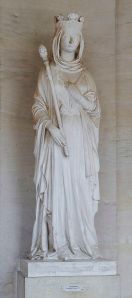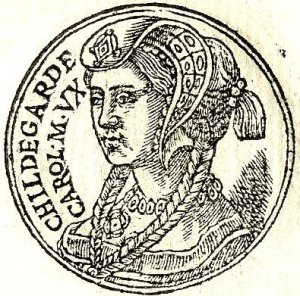Today I have another insightful guest post for the Women in History, or Women Making History, series I’ve been featuring on Oh, for the Hook of a Book! The article today is by Kim Rendfeld, historical fiction author of The Cross and the Dragon, a novel which is set in the time period of Charlemagne. In her book, her protagonist is quite independent. Kim has some great insights into the roles of women during this time period.
But first, to see my former review of Kim’s book click HERE or an in-depth interview with her, click HERE. Now, enjoy Kim’s post! If you have thoughts leave them in the comments!
Beyond Baby-Making: The Role of Carolingian Queens
By Kim Rendfeld
 Although seldom mentioned in annals, queens in Carolingian era (eighth and ninth century Francia) had a much more important role than a casual 21st century observer might think.
Although seldom mentioned in annals, queens in Carolingian era (eighth and ninth century Francia) had a much more important role than a casual 21st century observer might think.
If the king did not already have heirs, the queen’s primary role was to produce healthy sons to inherit the realm, and some kings tried to divorce wives unable to bear children. My main characters’ inability to conceive becomes a point of contention in my novel, The Cross and the Dragon. (Paradoxically, a Carolingian king would not want too many sons born in wedlock because each one of them would expect kingdom when his father died.)
Yet a queen’s responsibilities went beyond baby-making, and if the question of heirs was already settled, she could have tremendous influence.
From Wikimedia Commons: The statue is of Queen Bertrada, Charlemagne’s mother. It’s a 19th century cast of a statue of the 13th century at the Château de Versailles
The ninth-century treatise The Government of the Palace says the queen’s role is “to release the king from all domestic and palace cares, leaving him free to turn his mind to the state of his realm.”
This does not mean the queen is relegated to the role of housewife. In the Middle Ages, the personal and political were intertwined. The queen was the guardian of the treasury, and she controlled access to her husband. Alcuin, an influential scholar, wrote to the queen to find out where Charlemagne was spending the winter.
When houseguests were foreign dignitaries, royal hospitality was key to international relations. Hospitality was more than just showing good manners. Frankish royalty would want their guests to report to their own rulers that the palace was beautiful and sturdy, the baths were hot, the table was laden, the host well dressed, and the guards and servants well cared for. All signs of power, important to project even to one’s own allies whose support could shift.
From Wikimedia Commons: The drawing is a 16th century depiction of Hildegard, Charlemagne’s second wife.
Of course, this time period was hardly ideal for women. Girls as young as 12 or 13 were considered marriageable, and their families chose their husbands. Among aristocrats, marriage was most often for political reasons. Canon law gave women the right to consent to a marriage at age 15 or 16, but that could be beaten or starved out of them.
However, the reason for Women’s History Month and for posts like these is that too often women are portrayed only as victims and not as full human beings who could influence events around them and contribute to their societies. Carolingian queens certainly did both.
Sources
Women at the Court of Charlemagne, Janet Nelson
Daily Life in the World of Charlemagne, Pierre Riche (translated by Jo Ann McNamara)
Kim Rendfeld, Biography~
 Kim Rendfeld is the author of The Cross and the Dragon, a tale of love set amid the wars and blood feuds of Charlemagne’s reign. Her protagonist is Alda, a strong-willed Rhineland noblewoman. Two historical influential women, Queen Hildegard and Queen Mother Bertrada, are secondary characters in the novel.
Kim Rendfeld is the author of The Cross and the Dragon, a tale of love set amid the wars and blood feuds of Charlemagne’s reign. Her protagonist is Alda, a strong-willed Rhineland noblewoman. Two historical influential women, Queen Hildegard and Queen Mother Bertrada, are secondary characters in the novel.
Kim has a lifelong fascination with fairy tales and legends, which set her on her quest to write The Cross and the Dragon.
She grew up in New Jersey and attended Indiana University, where she earned a bachelor’s degree in journalism and English, with a minor in French. If it weren’t for feminism, she would be one of those junior high English teachers scaring the bejesus out of her students, correcting grammar to the point of obnoxiousness. Instead, her career has been in journalism, public relations, and now fiction.
Kim was a journalist for almost twenty years at Indiana newspapers, including the Journal and Courier in Lafayette, The Muncie Star, and The News and Sun in Dunkirk, and she won several awards from the Hoosier State Press Association.
Her career changed in 2007, when she joined the marketing and communications team at Ball State University in Muncie, Indiana. She gets paid to agonize over commas and hyphens, along with suggesting ways to improve writing, and thoroughly enjoys it. She is proud to have been part of projects that have received national recognition.
Kim lives in Indiana with her husband, Randy, and their spoiled cats. They have a daughter and two granddaughters, with a third due in May 2013.
The Cross and the Dragon Synopsis~
 A tale of love in an era of war and blood feuds.
A tale of love in an era of war and blood feuds.
Francia, 778: Alda has never forgotten Ganelon’s vow of vengeance when she married his rival, Hruodland. Yet the jilted suitor’s malice is nothing compared to Alda’s premonition of disaster for her beloved, battle-scarred husband.
Although the army invading Hispania is the largest ever and King Charles has never lost a war, Alda cannot shake her anxiety. Determined to keep Hruodland from harm, even if it exposes her to danger, Alda gives him a charmed dragon amulet.
Is its magic enough to keep Alda’s worst fears from coming true—and protect her from Ganelon?
Inspired by legend and painstakingly researched, The Cross and the Dragon is a story of tenderness, sacrifice, lies, and revenge in the early years of Charlemagne’s reign, told by a fresh, new voice in historical fiction.



Pingback: Carolingian Queens’ Role More Complex Than It Seems | Kim Rendfeld
The subject is new to me and I enjoyed reading about it. Thanks.
LikeLike
Your comments about the role of early queens struck a note with me: my WIP is called “None But a King” about Anne of Brittany, who became Queen of France twice when she married two successive kings, but was considered (By herself and others) a failure, since her nine pregnancies did not produce a king and heir.
LikeLike
I hope Kim sees this message!! You should for sure contact her and tell her you liked the post!
LikeLike
Pingback: History A’la Carte 3-28-13 | Maria Grace
Pingback: Bertrada: Queen Mother and Diplomat | Kim Rendfeld
Pingback: Queen Mother Gerberga: Protecting Her Sons – and Her Power | Kim Rendfeld
Pingback: History A'la Carte 3-28-13 - Random Bits of Fascination